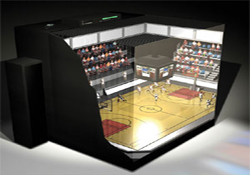Adding a new dimension
Posted by news
R2D2 is capable of displaying urgent messages from Princess Leia in three dimensions. But holographic technology is also possible in a galaxy no-so-far-away. In fact, Harold (Skip) Garner, NucE’76, has a machine in his Texas laboratory that is capable of generating holographic movies.
 |
| The future of TV will look something like this, according to UMR grad Harold "Skip" Garner. Image courtesy of John MacNeill Illustrations/www.johnmacneil.com. |
The prototype, which is six inches cubed, is the precursor to a holographic television. “We’ve had holographic cameras for awhile,” Garner says, “but, until now, we’ve never had the ability to display the images.”
Sure, you’ve probably seen non-holographic 3-D movies that require those cheap paper glasses. But this is different. The projection surface has volume, and laser technology is employed to create images in layers. No tacky glasses are needed.
“Right now, it’s not high resolution,” Garner says. “But we know exactly how to get there.”
And the beauty of this technology, according to Garner, is that it is compatible with current broadcast infrastructure.
Garner holds one patent related to his holographic television work and another is pending. In addition to being an inventor, Garner is a medical doctor, plasma physicist and biochemist at the University of Texas Southwestern Medical Center. His chair in developmental biology is endowed in part by the founders of Texas Instruments.
Within 10 years, Garner predicts that holographic televisions based on his prototype will be available to the public. He says 3-D images might seem surreal at first to people who have been programmed to watch flat images; but he’s confident the added dimension will change perceptions and expand entertainment options. Popular two-dimensional programs could be re-formatted in 3-D much like old black-and-white movies have been re-cast in color. And sporting events like the Super Bowl could be shot with holographic cameras.
“The only thing that we need is funding,” Garner says. “It’s time to take the technology out of the academic environment – and into a company.”
In the short term, the primary applications are in medical and military fields. Garner is already producing holographic movies of a human heart and an F-16 fighter jet. More information is available at http://innovation.swmed.edu.